Key takeaways:
- Pro-life advocacy is rooted in valuing all human life, with an emphasis on understanding and compassion during discussions about difficult circumstances surrounding conception.
- Respectful dialogue fosters trust and meaningful connections, allowing for a more productive exchange of viewpoints without escalation into conflict.
- Active listening and using “I” statements can transform heated conversations into empathetic dialogues, leading to deeper understanding.
- Creating a supportive environment and focusing on shared values can shift discussions from contention to collaboration, enhancing mutual respect among differing perspectives.
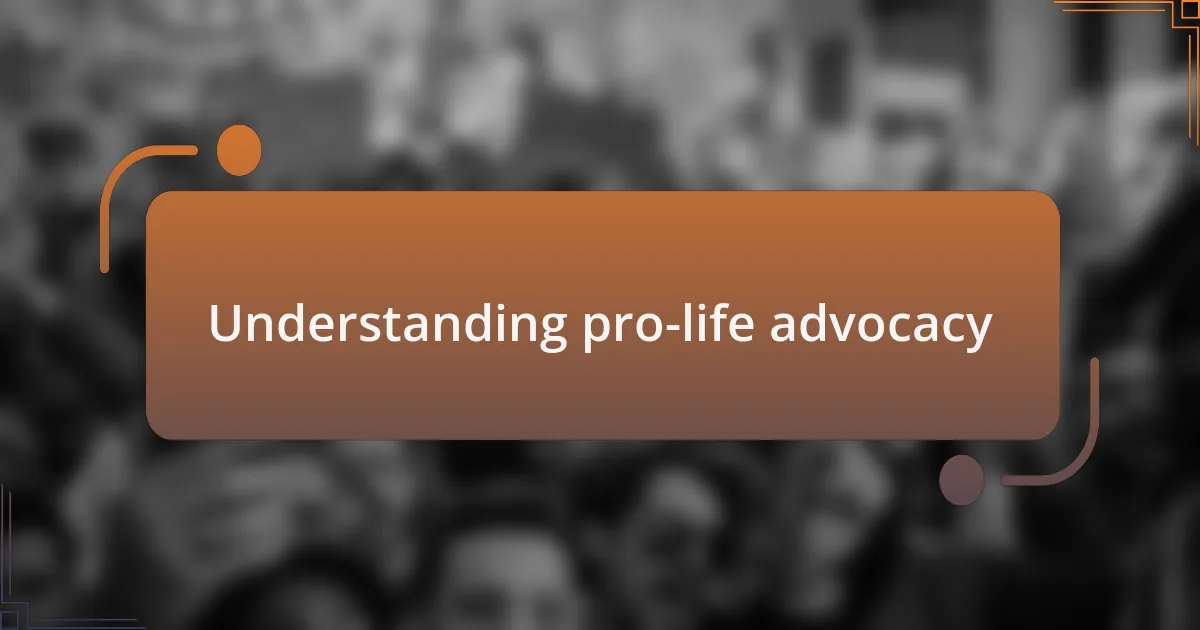
Understanding pro-life advocacy
Pro-life advocacy centers on the belief that all human life, particularly the unborn, has inherent value and deserves protection. I remember the first time I attended a pro-life rally; the energy and passion in the crowd were palpable. It made me reflect on the reasons behind my own beliefs and how deeply intertwined they are with my values about human dignity.
In conversations around pro-life advocacy, I often encounter the question: “What about the circumstances of conception?” This question can be tough, but it opens a vital dialogue about compassion and understanding. Personally, I’ve found that sharing stories of women who faced difficult pregnancies can bridge this gap, emphasizing that support and love can coexist alongside serious challenges.
Moreover, the emotional aspect of pro-life advocacy can’t be overstated. When I meet someone who shares their experience of regret after an abortion, it reaffirms the importance of advocating for alternatives. It isn’t just about the issue; it’s about real lives and how we can engage with one another empathetically, fostering a culture that values every individual, no matter their circumstances.
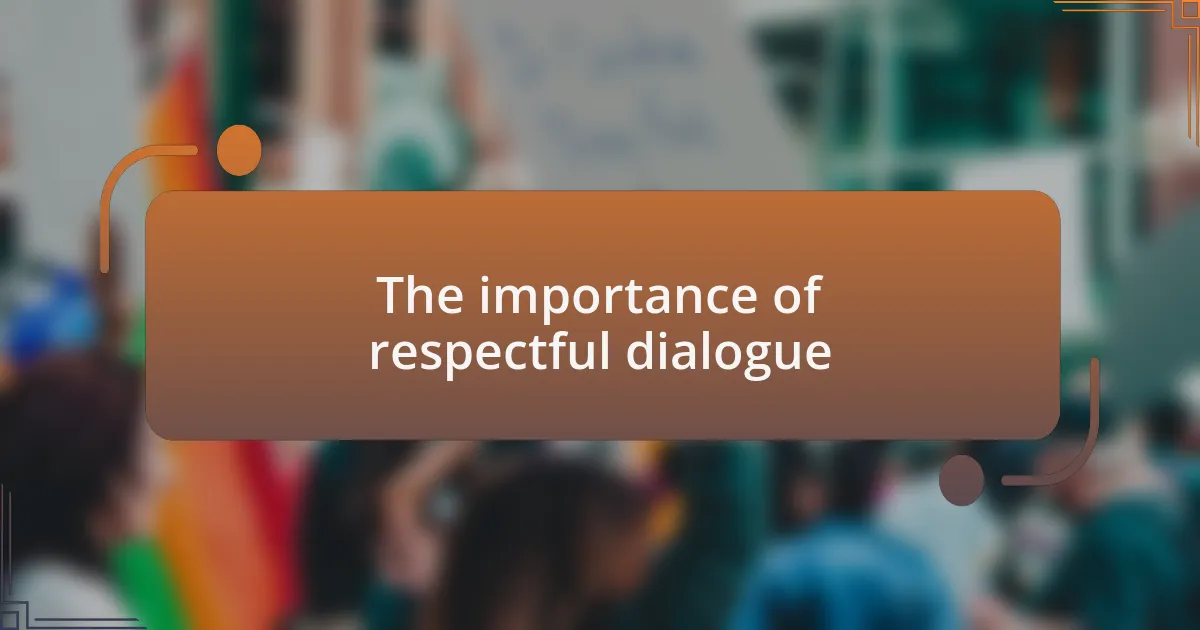
The importance of respectful dialogue
Engaging in respectful dialogue is crucial in pro-life advocacy because it helps us connect and understand differing viewpoints. I remember a particularly difficult conversation with a friend who was pro-choice. Instead of debating aggressively, I chose to listen and share my own perspective on the sanctity of life. It was through this respectful exchange that we found common ground on the importance of care and support for mothers in challenging situations.
Respectful dialogue also fosters trust and opens the door to more meaningful discussions. In one instance, at a community meeting, I noticed how much more receptive people became when the conversation remained calm and focused on mutual respect. When we avoid inflammatory language and accusations, it allows everyone to share their experiences and opinions freely. Have you ever noticed how a simple change in tone can completely shift the dynamics of a conversation?
Moreover, approaching sensitive topics with kindness can lead to transformative moments. I once spoke with a woman reflecting on her past abortion; instead of casting blame, I offered understanding—her vulnerability in sharing her story became our bridge. Through such experiences, I’ve learned that when respect is at the forefront, even the toughest conversations can nourish empathy and foster deeper connections among us.
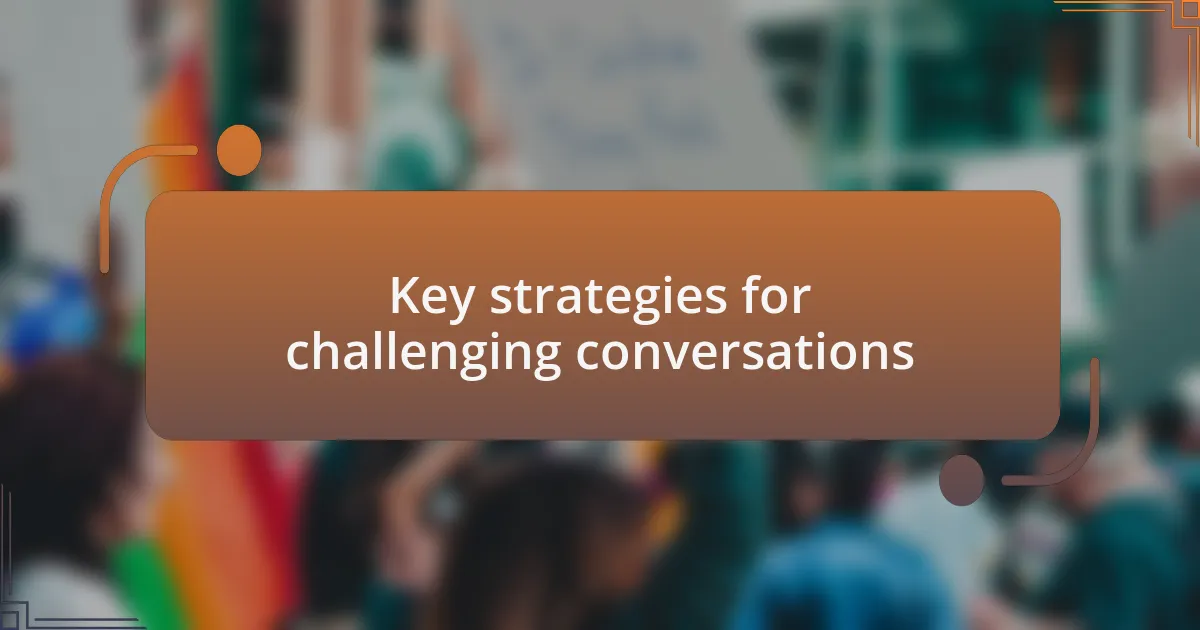
Key strategies for challenging conversations
When navigating challenging conversations, clarity and focus on the topic are essential. I recall a discussion at a local gathering where someone raised a controversial point regarding abortion rights. Instead of allowing the conversation to drift into personal attacks or emotional outbursts, I steered it back to our core beliefs. By framing the discussion around specific questions, we maintained our focus, fostering a more productive dialogue.
Equally important is the practice of empathy. I once spoke with a colleague who held a starkly different view on reproductive rights. As I listened to her experiences and concerns, I realized that her feelings stemmed from deeply personal experiences. It drove home the point that understanding another’s perspective isn’t about conceding your beliefs; rather, it’s about inviting openness. Have you ever considered how the act of genuinely listening could transform a conversation from a potential conflict into a genuine exchange?
Finally, I’ve learned that timing matters. In one heartfelt moment, I approached a friend during a quiet afternoon to discuss our differing views. Timing allowed us both to be at ease, which resulted in a heartfelt exchange. We often overlook that a well-timed conversation can create an atmosphere where people feel safe to express their thoughts. Have you thought about when the right moment might be to have these tough discussions? It’s those moments that often lead to breakthroughs in understanding.
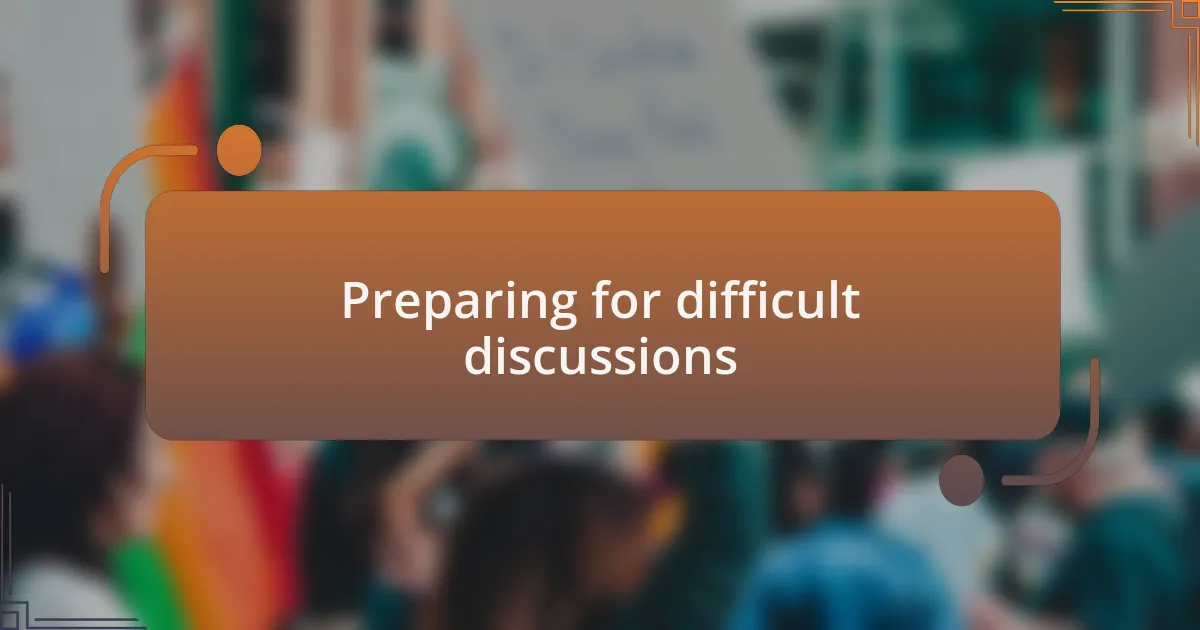
Preparing for difficult discussions
Preparing for difficult discussions requires careful consideration of the environment and context in which you engage. I remember one time, I attended a community event where strong opinions about pro-life advocacy were sure to surface. Before I spoke, I took a moment to assess the mood in the room—it felt tense. Choosing a quieter, more intimate setting within the event proved beneficial. Have you ever noticed how the right environment can make all the difference in how open people are to dialogue?
Anticipating potential emotional responses is another important aspect of preparation. In a previous conversation, I felt a wave of tension when someone brought up personal experiences related to abortion. Recognizing the emotional weight of the subject helped me pause and acknowledge their feelings before proceeding with my points. It became clear that addressing the emotions present allowed for a more respectful discourse. Have you reflected on how emotions influence conversations and how your approach to them can shape the outcome?
Finally, it’s crucial to formulate clear objectives for the discussion. There was a notable instance when I approached a friend with the intent to share ideas and not to win an argument. I articulated my goal to understand her perspective. This clarity helped trim the fat from our conversation, allowing us to dive into meaningful dialogue. Have you ever defined what you want to achieve before engaging in a tough talk? Setting focused intentions transforms difficult discussions from contentious debates into opportunities for learning and growth.
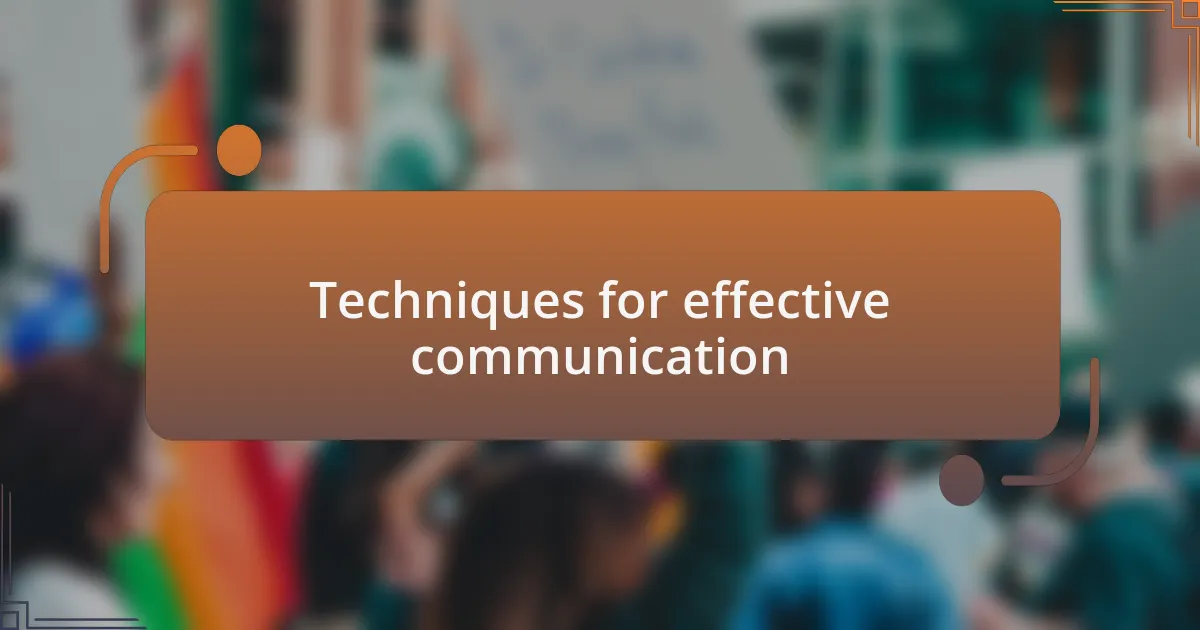
Techniques for effective communication
When it comes to effective communication, active listening is a game-changer. During a challenging discussion with a family member, I noticed that simply nodding and paraphrasing what they said created a bridge of understanding. It felt like unlocking a door; they became more willing to share their thoughts without the fear of being dismissed. Have you ever felt the power of being genuinely heard, and how that shaped the direction of a conversation?
Another technique I’ve found invaluable is using “I” statements to express my feelings and opinions. For instance, while discussing difficult topics, I often begin with phrases like “I feel” or “I believe.” This approach softens potential defensiveness and focuses on my experience rather than making sweeping accusations. I remember a time when I expressed my perspective this way, and it encouraged the other person to respond in kind. Can you recall a moment when a simple change in wording shifted the tone of a conversation for you?
Finally, asking open-ended questions can fuel a richer dialogue. I realized this during an intense debate at a school meeting where opinions clashed. Instead of presenting my viewpoint forcefully, I started asking, “What do you think the main concerns are?” This tactic not only redirected the focus but also invited others to share their thoughts more fully. Reflecting on how openness invites connection, have you experienced a conversation transformed by allowing others space to express themselves?
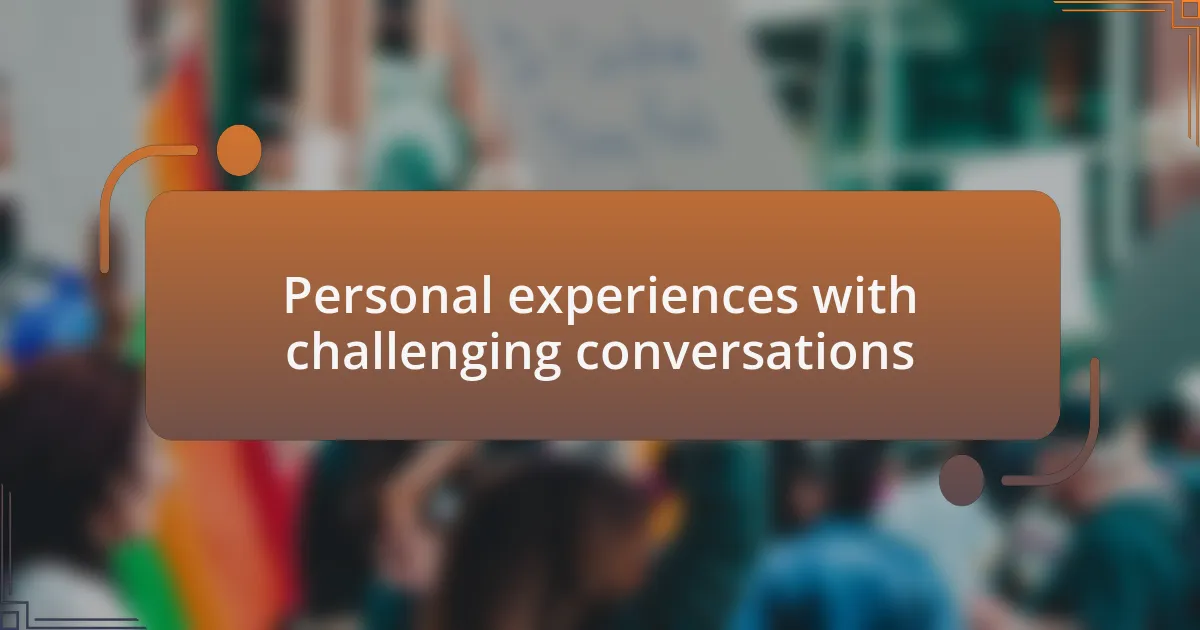
Personal experiences with challenging conversations
Navigating challenging conversations often feels like walking a tightrope, especially when it comes to sensitive topics like pro-life advocacy. I remember a particularly heated discussion with a close friend who held a starkly different viewpoint. Instead of pushing back, I chose to reflect on my emotions about the issue, sharing how personal experiences shaped my beliefs. The moment I told them how close I felt to the topic because of my own journey, the atmosphere shifted; they started to listen with empathy rather than defensiveness.
Another instance that stands out involved a workplace debate on policy that sparked passionate reactions. I decided to frame my concerns not around opinions, but around shared values, such as care for families and respect for human life. By tapping into common ground, I noticed people’s walls crumbling, and we built a more constructive dialogue instead of getting tangled in our disagreements. Have you ever realized that focusing on what unites us can create a pathway to understanding?
Lastly, I vividly recall discussing these themes with my elderly neighbor, whose views are generations apart from mine. I approached the conversation with a genuine curiosity, asking her about her life experiences and how they informed her beliefs. As she shared stories filled with hope and regrets, I felt a strong connection forming, despite our differences. In that moment, I learned that engaging deeply with someone’s personal narrative can transform a potentially confrontational dialogue into a meaningful exchange. Isn’t it amazing how the simplest act of curiosity can reveal shared humanity?
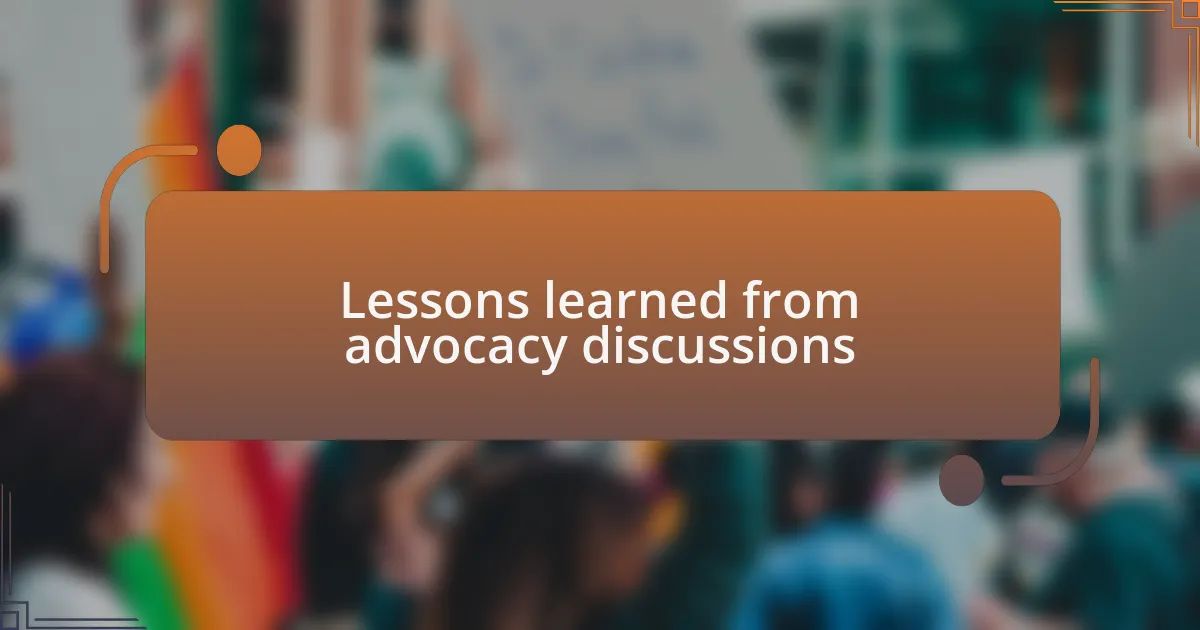
Lessons learned from advocacy discussions
Engaging in advocacy discussions has taught me the importance of patience and understanding. I vividly remember an online forum where debates could spiral out of control at any moment. I took a step back and realized that responding with kindness, rather than frustration, not only calmed the situation but encouraged others to approach me more openly. How often do we forget that our tone can change the entire trajectory of a conversation?
In another situation, I found myself in a community workshop, surrounded by passionate voices on all sides. I learned that sometimes, listening is the most powerful tool I have. When I took the time to truly hear someone’s story before responding, it was like opening a door to a room filled with possibilities. It prompted me to ask deeper questions, inviting others to reflect on their views. This experience reaffirmed that vulnerability fosters connection; isn’t it incredible how sharing our fears can lead to unexpected alliances?
Finally, I’ve discovered that framing discussions with respect goes a long way. Once, while engaging in a panel discussion, I chose to highlight the shared goals we all desired for our families and society. Instead of emphasizing differences, I pointed out mutual aspirations, creating a supportive environment. It sparked a sense of collaboration rather than division. Isn’t it fascinating how a shift in perspective can illuminate paths forward, encouraging everyone to work together instead of apart?